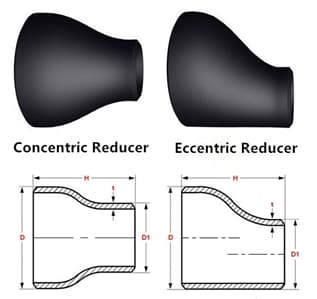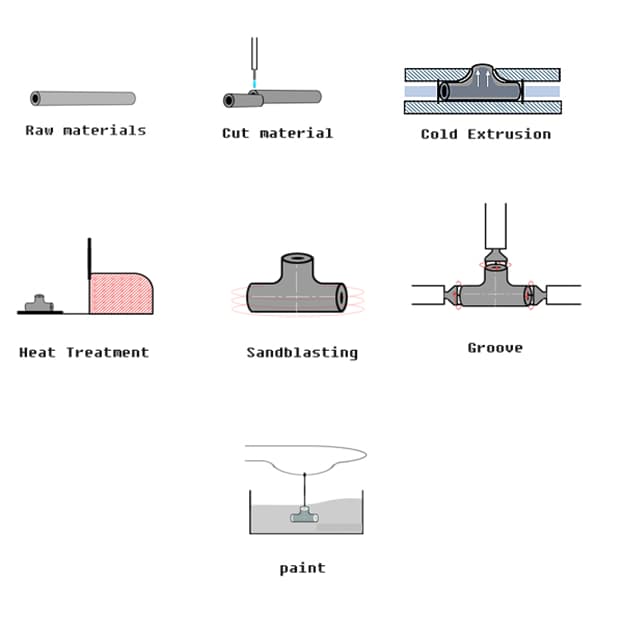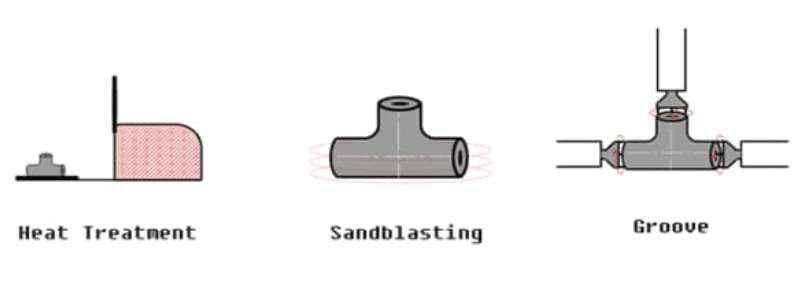Definition of Tee
T The tees are generally called ‘Pipe Tee’ which has a shape like a letter ‘T’ and connects 3 different or the same pipe. Tees generally have a 90-degree angle between their inlets. They can be used for industrial purposes as well as commercial purposes. They can be in any size depending on the request. The main raw materials of tees can be iron, aluminum, plastic, copper, stainless steel, rubber, carbon steel, brass, etc.
Fitting Types of Tees
There exist a few types of tee pipe fitting that can be used for different needs and those are:
- Straight Tee Fitting
- Reducing Tee Fitting
- Male and Female Branch Fitting
- Male and Female Run Fitting
- Wye Tee and Lateral Tee Fitting
Definition of Reducers

The reducers are also called ‘Pipe Reducers’ like the tees and they are used to reduce the diameter of the pipe. The most common reducers are concentric reducers and eccentric reducers. The concentric reducers seem like a cone since the centerline of the two-pole are the same and it is symmetric. The concentric reducers are also known as conical reducers. The eccentric reducers, on the other hand, are symmetric and one side of the reducer is straight since the centerline of poles is not the same. As it is seen in Figure 1 they are not quite similar yet, they both can accomplish relative to the need. Since the eccentric reducers are asymmetric they create asymmetric flow conditions and this results in high flow velocity on the flat side and low flow velocity on the other. This asymmetric flow causes a pressure increase. The main and most significant difference between concentric and eccentric reducers is the cavitation which is a buildup of air bubbles in the system. The concentric reducers can generate air bubbles in the system while the eccentric reducers do not. This advantage of eccentric reducers is used in the suction side of pumps since the cavitation can damage the pumps. The vertical pipelines generally use concentric reducers while the horizontals use eccentric.
Manufacturing Methods of Tee
There exist two different methods of manufacturing pipe tee which are Hydraulic Bulge Method, Hot Extrusion Method. These two types of manufacturing methods have both common as well as different aspects.
Hydraulic Bulge Method
To start with hydraulic bulge method uses high pressured fluid to shape the metal or material. The process begins with the receiving inspection of the piece and cutting it to the required size than the hydraulic pressure slowly generates a bulge commonly in the middle of the piece yet, the bulge area can be changed by demand. The bulging method can be represented below figure, at the cold extrusion step, as it can be seen the fluid tries to push the zone that is not supported or pressed intentionally. Then the piece is heated to ensure that it is reliable and rigid. This heat treatment makes the piece almost liquid to have an even distribution of metal and not to have cracks. After the heat treatment, the piece is cleaned and shot blasted, in other words, machining to have a perfect and smooth surface. Lastly, the piece is coated to resist rust and for other corrosion reasons. This method is not used for the diameter of tees.

Hot Extrusion Method
Like the hydraulic bulge method, the hot extrusion method also starts with an inspection of pieces and cutting. Then the pipe is heated to prepare it for extrusion since cold extrusion can break the pipe. After that, a spherical metal piece pulled through to cut this heating and pulling called forming process. Although this method is called “hot” extrusion and the piece is heated while the forming process, is applied heat treatment to the piece with the same reason in hydraulic bulge method. Besides, the rest of the process is the same with the hydraulic bulge method machining, cleaning, beveling, and coating
Manufacturing Method of Reducers – Outer Die Method
The most common method of manufacturing reducers is Outer Die Method. It is almost the only method that manufacturers use today. The operation starts, as usual, receiving inspection and cutting. Then the pipe is pressed into formwork which is also called an outer die. The end of the pipe is compressed to a smaller size since it is better to compress materials to the smaller size than the compressing to the greater sizes so the material does not break while the process. After compression which is also called forming process, the heat treatment starts as usual. The rest of the process is the same with tee manufacturing methods: Machining, cleaning, beveling, and coating
Other Methods
There exists one primitive method compared to the other methods and it is rarely used for too specific operations or tees and reducers. This method is called the Single or Double Seam Method which is the welding of two pieces. The pieces are produced by using formwork and they consist of two symmetrical sides of the tee or reducer. Finally, the pieces are welded before machining, cleaning, and coating.
YENA Pipe can supply tees and reducers manufactured by the above-mentioned methods, complying with various standards like ASME, DIN, and EN standards. Check out our page if you are interested.
YENA Pipe: https://yenapipe.com/
You may check also this article : Pipe Spool Applications


